This post may contain affiliate links, please view our disclosure policy for more details.
Bonus Material: Free workshop for moving on from purees gradually to eliminate the fear of gagging and choking
Gagging and choking. *cringe*
Two of the most concerning topics for parents when introducing solid foods to babies.
And rightfully so!
As parents, our minds whirl around endlessly with the “what ifs” and “how to’s” on this topic, and to be honest, mine did too when starting solids with my babies!
So, let’s clear the air, and let me help you ease your thoughts a little, as educating yourself and understanding the what, why, and how of gagging and choking is key to making mealtime so much more stress-free!
PS – I’ve got a free workshop for you to help you overcome your fear of gagging, choking, and taking big bites of food. I give you my best tips as a mom and feeding expert for how to remove any anxiety around gagging, and will cover how to gradually advance from purees to solids at a pace that works for you and your baby – without the fear!
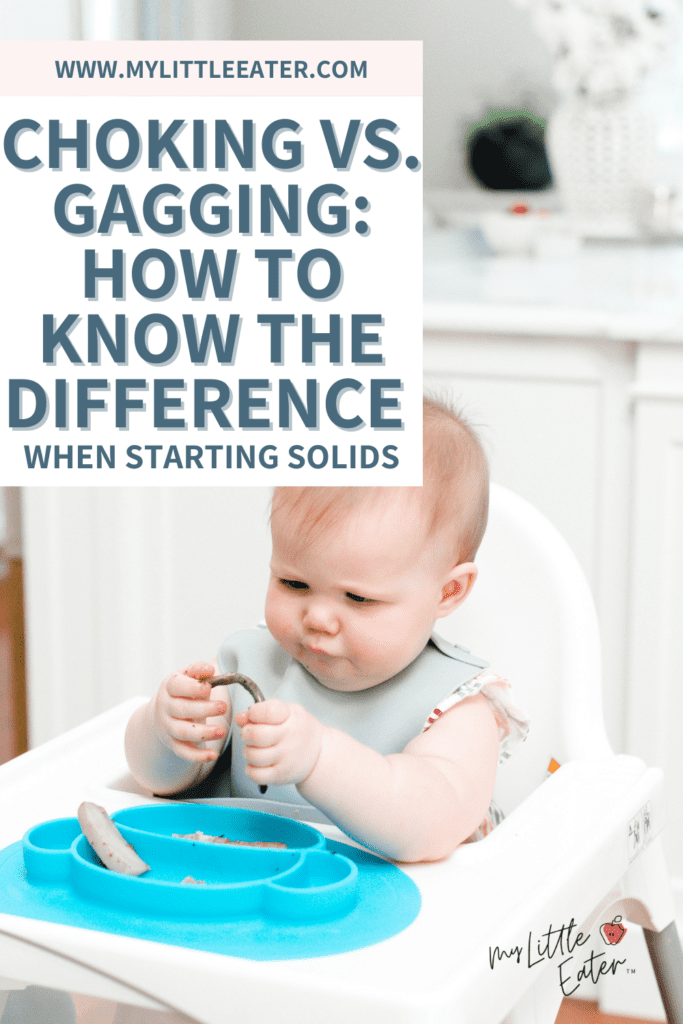
Like most parents, you probably have a long list of questions such as…
“How do I prevent my child from choking?”
“How can I tell the difference between gagging vs. choking?”
“What do I do if any of these happen?”
And finally….
“How do I get over my extreme fear of choking!?”
And let’s be honest, these are probably just the tip of the iceberg. Once you actually start to let your baby eat solid food, and you witness them gag for the first time, you’re probably going to have some new concerns…like: “When does it stop?!” and “OMG, they vomited, is that normal?!”.
So here we go. Let’s dive in and get you all the answers you need!

Table of Contents
What is gagging?
So first, let’s define gagging.
Gagging is a protective mechanism that we’re all born with to help prevent food from entering the back of the throat (where your airway is), or in other words, the ‘danger zone’ (1).
In fact, it’s a reverse swallow!
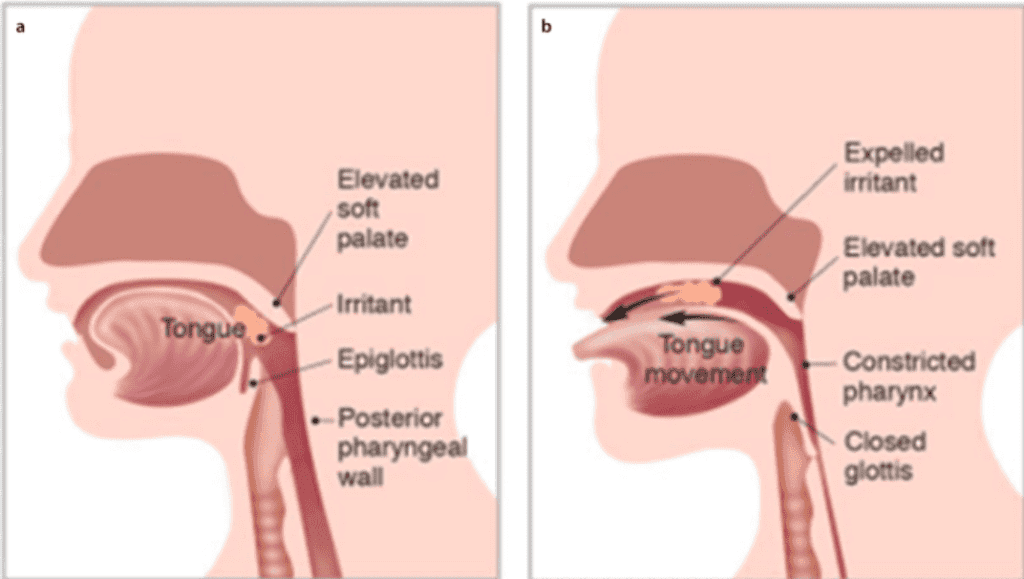
Instead of propelling food back with the tongue, it expells it by contracting the pharynx and pushing the food out with the tongue. Notice in the image above that the airway is actually closed with a gag (the epiglottis covers the airway) (2). This means – your baby can’t choke on food when it’s being caught by the gag reflex! It’s pretty amazing.
Is it normal for babies to gag during baby led weaning?

Although gagging may look scary or uncomfortable for your baby, it’s a completely normal and natural response when babies are transitioning to solid foods. In fact, most babies aren’t even remotely bothered by it and will continue eating right away. It doesn’t cause them any discomfort or worry them whatsoever…parents, on the other hand, tend to feel much differently!
In the early stages of starting solids, your baby’s gag reflex is triggered when food or an object is near the front 1/3 of their tongue. This keeps baby safe when practicing with new foods, or food of different textures. While learning how to manipulate food and control it better in the mouth, the gag reflex is active and firing away – something we want to see – so they can practice with extra protection (3)!
Then, as your baby gets more practice with various solid foods, and masters how to control the food in their mouth better, the reflex trigger starts to move backward over time, until it sits right at the top of the throat, where most adults’ gag reflex is (3).
So the process of gagging isn’t a bad thing or an indication that something is wrong. It’s normal, necessary, and welcomed during the learning phases of starting solids!
Is it normal for babies to gag and throw up?

Gagging may sometimes lead to vomiting. This is a normal response and is usually more traumatic for parents than babies themselves.
We recommend doing a quick wipe down if baby isn’t upset and allowing them to finish the meal. As their gag reflex becomes more desensitized, and they get more practice with various textures, you should notice the frequency of this decrease. If you don’t, you will want to reach out to their doctor and request a feeding evaluation.
Larn more about when an evaluation is recommended and what other red flags there are to watch for in our blog on excessive gagging.
Why do babies gag?

There are a few reasons why a baby may gag, and some may surprise you!
First off, gagging does not mean that your baby’s choking! They are two different, mutually exclusive events, and gagging doesn’t cause choking, nor does it mean that your baby is about to choke. Choking can happen with or without a gag first. With gagging, your baby’s airway is open and safe! They’re good mama!
It also doesn’t necessarily mean your child doesn’t like a particular food. It could be that your child is experiencing a texture or size of food they aren’t used to, or perhaps, it’s a very familiar food type and size, but they’re just having a hard time moving food around in their mouth.
We often see parents stop offering food that a baby previously gagged on. But this isn’t something to run away from or a sign you should switch up the type of food offered. It’s actually totally fine for them to experience gagging (and encouraged) so they can advance in their eating skills. In fact – we want them to get more practice with it!
Gagging can happen with purees just as much as with finger foods! When a thin, watery liquid is placed right in the middle of the tongue, it spreads quickly and is hard to control. That’s why offering your baby water often causes more gagging and coughing than a thicker puree would! Regardless, every baby is different, and what makes one baby gag is different than another. Trying to avoid gagging altogether by only offering smooth or thin purees isn’t necessarily the answer.
When babies are allowed to gag on foods of different textures and finger foods, they build their oral-motor skills. These are basically all the skills required to move the lips, tongue, cheek, jaw, etc effectively and safely perform movements like sucking, biting, crunching, nibbling, chewing, grinding, and swallowing. Without practice on more advanced textures or finger foods in the early months (6-8 months of age), you actually risk the underdevelopment of oral motor skills. That’s why the gag reflex is designed to be more sensitive in the beginning during those earlier months of starting solids (rather than ages 9-12 months). It’s so that baby can practice with different foods, and build their oral motor skills during this critical learning period.
Signs of gagging
We want to be able to identify when a baby is gagging very easily, so we don’t mistakenly believe they’re choking and panic. We want you to be able to ease your mind, knowing that your baby is ok.
So with that in mind, let’s take a look at what gagging looks like:

Signs of gagging include:
- Watery eyes (tears are normal!)
- Red face (from straining to push food out!)
- Open mouth with tongue thrust forward
- Some type of noise being made from the mouth is possible (it could be coughing, crying, belching, etc. – all these are great signs that your baby’s airway is NOT blocked!)
Watch the video below to learn more.
What to do when your baby is gagging
Reacting appropriately is crucial to ensuring that your baby stays safe throughout the gag. In fact, it might surprise you to learn that the less you do, the better. Let’s go over the details.

Don’t overreact when gagging happens
Although this is really hard to do, it’s best not to overreact when your baby is gagging. This means trying your best to avoid panicking in front of your baby, as this may scare them and can cause mealtime to be more stressful for both of you.
When a baby sees their parent panic over a gag, they begin to think that it’s a bad thing. They may even begin to develop an aversion to any food that makes them gag, they could avoid food of a particular texture or size, or even avoid mealtime altogether if it always seems like a stressful place.
For the most part, babies are pretty unphased by gagging, so let’s keep it that way. Try to sit back and just let your baby work through it. Which brings me to my next point…
Never interfere with a gagging baby

Interfering by, for example, sticking your fingers in baby’s mouth to get the food out, or picking your baby up out of the high chair as they gag, will only increase the risk that the food gets pushed (or falls) back further into their mouth, which can cause actual choking!
Sometimes our fear causes us to react before we really have had time to think through if we need to or not. That’s why it’s so important to overcome that fear! You need to be able to see gagging as a good thing, to allow your baby the space to deal with it on their own, and in turn, keep them safe.
If that feels impossible, I’ve got a free workshop for you that will help you overcome your fear of gagging, choking, and taking big bites of food. I give you my best tips as a mom and feeding expert for how to remove any anxiety around gagging and will cover how to gradually advance from purees to solids at a pace that works for you and your baby.
When babies are gagging, they are in control. And so the chances of them figuring it out on their own are much higher than if we interfere. Let them stay in control.
The incident may take a few seconds, or a couple of minutes (I know… hard to watch), but their bodies do a great job of protecting themselves, so let’s not interfere and possibly make things worse.
How long do babies gag for when learning to eat?

Most babies who are doing baby led weaning gag more in the beginning since the food sizes and textures are more challenging from day one. But, their gag reflex quickly diminishes after a couple of months of practice and increased development of their oral motor skills.
With purée feeding, on the other hand, gagging seems to happen less in the beginning (although it can still definitely happen!). Then, once babies begin getting more advanced textured foods, and bite-sized pieces of food, cue the gagging!
Really, it’s unavoidable with both methods and getting comfortable with it is key!
When should I worry about baby gagging?
Although gagging is extremely normal when starting solids, and when moving on to more advanced textures, you do want to see it get better over time.
Some things to look out for are excessive gagging at every meal, frequent vomiting with gags, gagging on specific textures only, and gagging that hasn’t decreased despite weeks/months of practice.
To learn more about what would be considered excessive gagging and get more details on the red flags to watch out for and what to do if you notice them, read our blog on excessive gagging here.
Now that we have a thorough understanding of gagging, let’s talk about the worst-case scenario – aka choking.
What is choking?
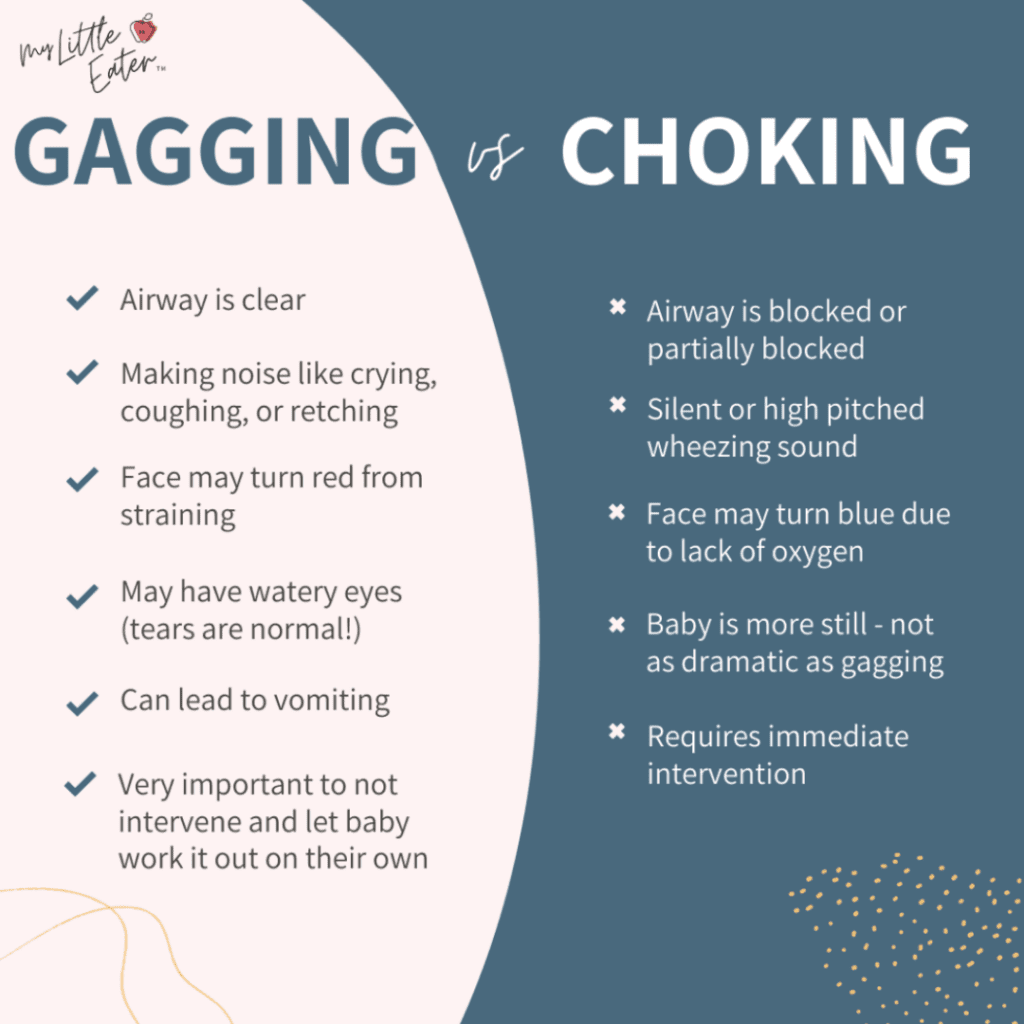
Choking is when food moves past the gag reflex and into your baby’s airway causing partial or full obstruction of the airway. This allows little or no oxygen to get to the lungs, which means your baby will have trouble breathing. Choking is much more serious than gagging, and requires immediate intervention.
Believe it or not, the choking risk is the same for babies who are purée fed vs. those who are doing baby led weaning (4). The key in both situations is doing each safely, and serving food in a manner that reduces the risk of choking (keep reading to learn how to do this).
Signs of baby choking
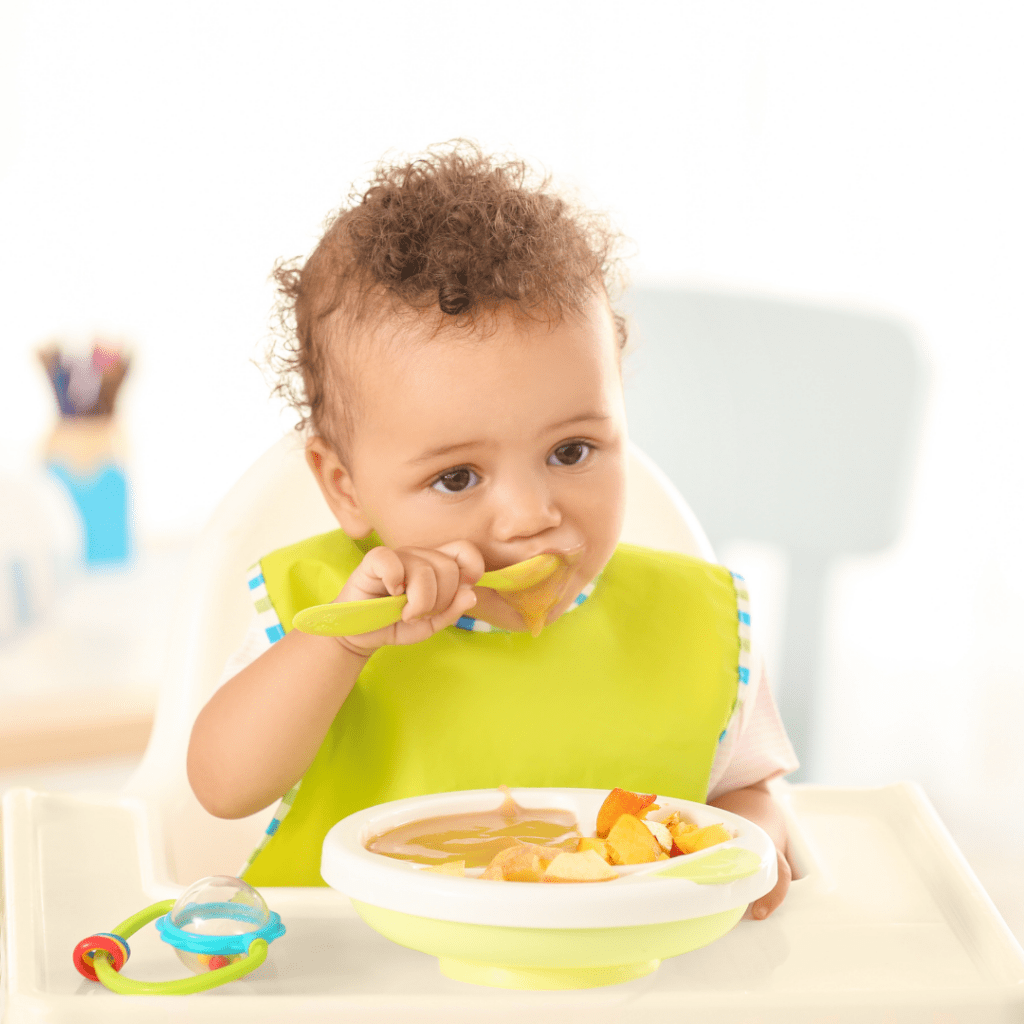
We need to be able to immediately identify the signs of choking (vs. gagging) so we can act (or not act) quickly.
Signs of choking include:
- A blank stare or panicked look (a sign they’re in distress)
- Blue skin or lips (indicating lack of oxygen to the lungs!)
- Silence or sometimes a high-pitched wheezing sound if only a small amount of air is getting through (babies will not be able to cry or make deliberate noise though!)
- Much less dramatic than gagging (baby is usually more still)
Because the signs of choking can’t be heard, it’s extremely important to always watch your baby when they’re eating so you can catch the signs quickly.
What to do when your baby is choking

If your child is choking, you’ll want to immediately intervene and begin infant CPR. We highly recommend taking a local (or online) class on infant CPR prior to starting solids with your baby to know exactly how to respond in this situation (read all the reasons why you need to take one, here).
Our absolute favorite and the most comprehensive online course for child/infant CPR and choking prevention is by Safe Beginnings. It’s extremely thorough, taught by a leading certified CPR instructor, Holly Choi, and has high-quality videos you can watch and practice alongside of, again and again. You will be prepared for the worst, should it happen, which is something truly worth investing in. Use code MYLITTLEEATER for 20% off and enroll in their course today.
You can also bundle our Baby Led Feeding online course + their Infant CPR course to save even more! This bundle works out to a savings of $45 – and has lifetime access to both, so take your time and start when you’re ready!
How do I decrease choking risk?
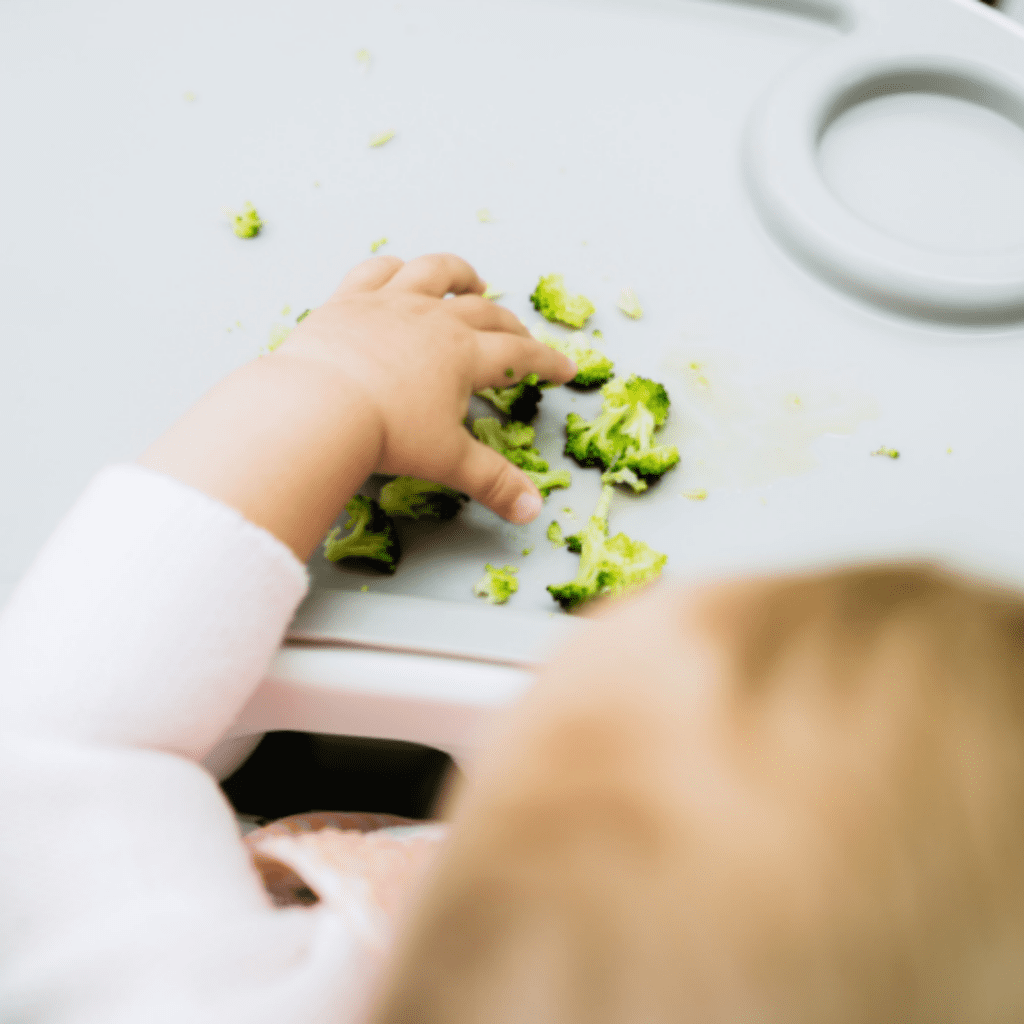
There are things you can do to ensure that your baby is safe at mealtime and that their choking risk is reduced as much as possible. Here is what we recommend doing:
- Get educated on how to offer appropriate textures and shapes of food (whether purée feeding or baby led weaning – our Baby Led Feeding online course is exactly what you need!)
- Make sure your baby is developmentally ready for solids
- Have baby sitting upright during mealtime
- Minimize distractions as much as possible (such as TV, toys, etc.)
- Always be present when your baby is eating
- Have your baby face you when they’re eating (remember choking is silent…you need to be able to see their face)
- Never put finger foods in baby’s mouth yourself and never attempt to fish food out of their mouth
- Take an infant CPR class!
Ok – so we really hope this helps set the stage for the basics of gagging vs. choking. And if you’re still feeling terrified about gagging – don’t forget about our free workshop – “Baby Led Weaning (but make it purees!) How to progress from purées to finger foods…without the fear!”.
In the workshop, we teach you about our signature Texture Timeline™ which allows you to introduce foods gradually, either purees or solids, at a pace that works for you and your baby so you can eliminate any fear of gagging, choking, or big bites. Spots are limited, so reserve your seat now!
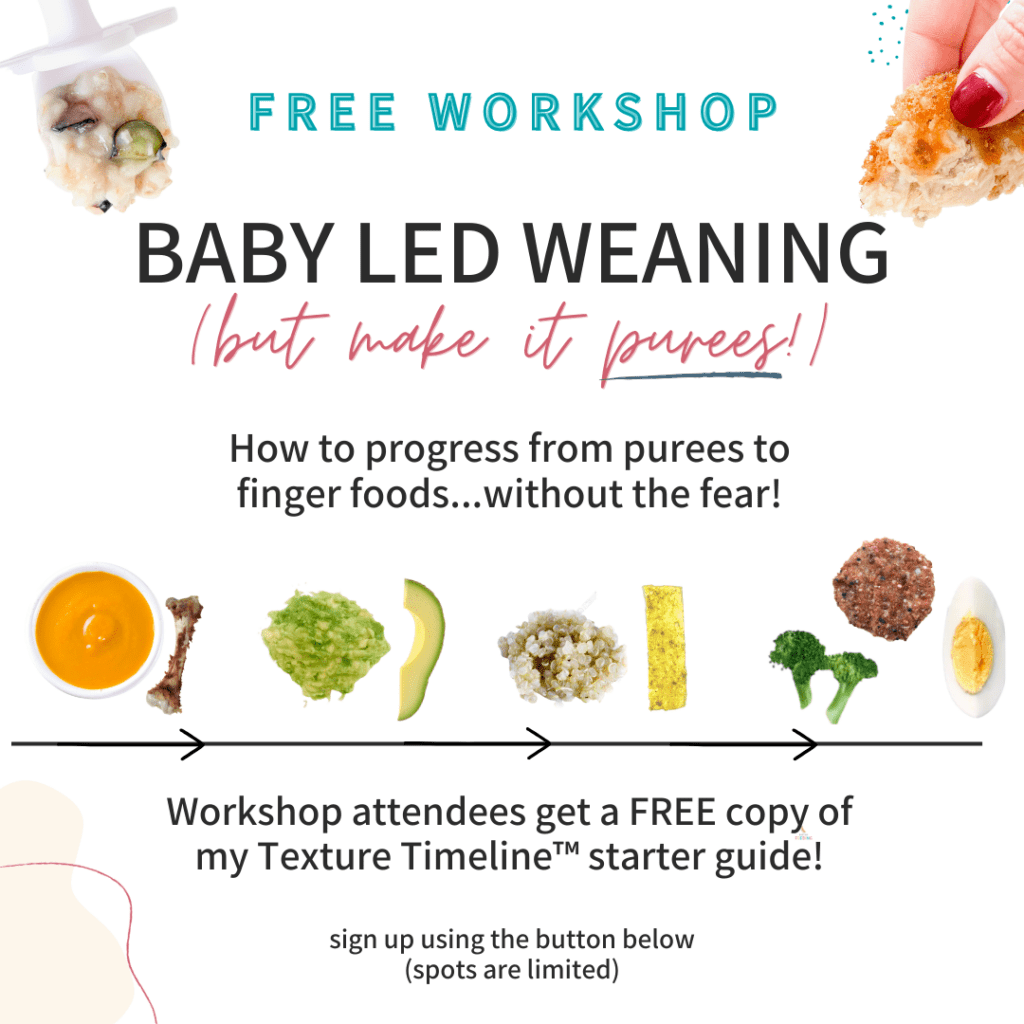
Did you find this helpful? Pin it to save for later!
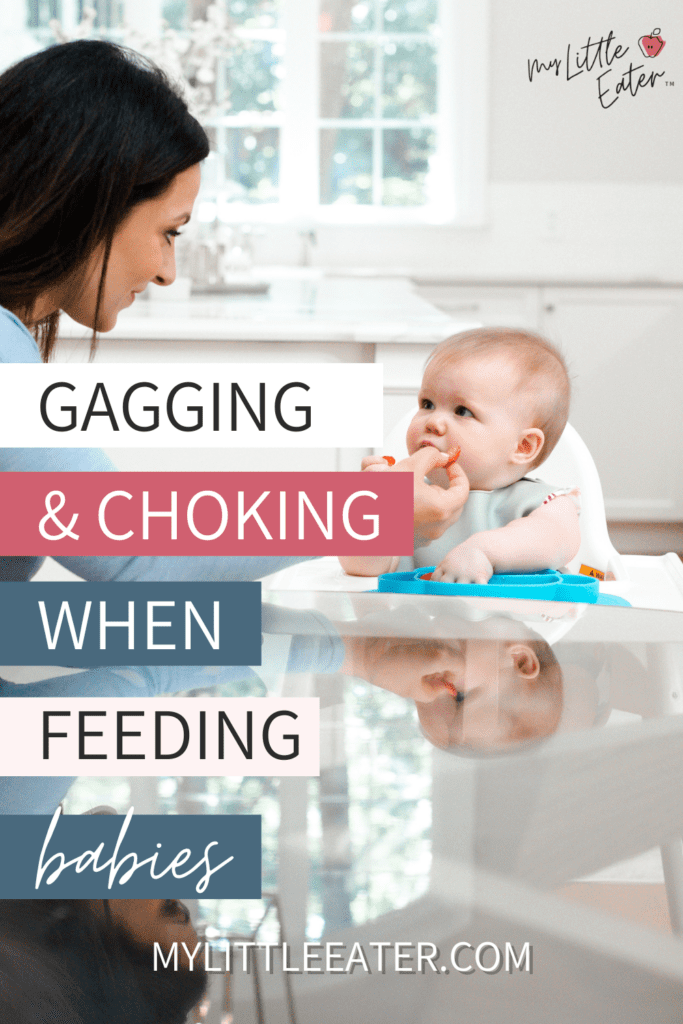
References:
- Sivakumar S, Prabhu A. Physiology, Gag Reflex. 2023 Mar 12. In: StatPearls [Internet]. Treasure Island (FL): StatPearls Publishing; 2023 Jan–. PMID: 32119389.
- Agdal, M.L., Høyvik, A.C., Gudmundsen, M.H., Myran, L. (2022). How to Deal with Gagging. In: Willumsen, T., Lein, J.P.Å., Gorter, R.C., Myran, L. (eds) Oral Health Psychology. Textbooks in Contemporary Dentistry. Springer, Cham. https://doi.org/10.1007/978-3-031-04248-5_16
- https://www.ncbi.nlm.nih.gov/pmc/articles/PMC2597750/
- https://publications.aap.org/pediatrics/article-abstract/138/4/e20160772/52372/A-Baby-Led-Approach-to-Eating-Solids-and-Risk-of?redirectedFrom=fulltext

ABOUT THE AUTHOR
EDWENA KENNEDY, RD
Founder and lead Registered Pediatric Dietitian at My Little Eater Inc., creator of The Texture Timeline™, and mom of two picky-turned-adventurous eaters.

ABOUT THE AUTHOR
EDWENA KENNEDY, RD
Founder and lead Registered Pediatric Dietitian at My Little Eater Inc., creator of The Texture Timeline™, and mom of two picky-turned-adventurous eaters.








